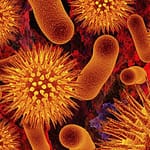 by The Crohn’s Infection Site Administrator
by The Crohn’s Infection Site Administrator
In this age of organic food, chemical free products, farmer’s markets and going green, it’s no wonder that Dietzia spp. C79793-74 is generating great interest among Crohn’s disease patients. After all, if this emerging probiotic therapy could curtail the symptoms of Crohn’s disease as well as, or even better than, conventional therapies but without the side effects, it may well become the future of Crohn’s treatment. While human research and trials need to be completed, Dietzia has shown promise in cattle infected with Johne’s disease. With new information emerging about this bacterial species, we thought our readers would enjoy this timely overview. We are honored to introduce the man who discovered benefits of Dietzia spp. C79793-74, Dr. Robert E. Click. His work with Dietzia began when an unexpected auction-associated disease accompanied heifer additions to his dairy herd.
Dr. Click received his Ph.D. from the University California, Berkeley and completed postdoctoral studies at Columbia Medical School, Sloan Kettering Cancer Institute, and the University of Wisconsin. He has published more than 40 papers in peer-reviewed journals and perhaps is best known for defining the advantages of adding 2-mercaptoethanol to tissue culture medium, and more recently, for defining its potential disease preventative properties.

by Dr. Robert E. Click
Probiotics are living organisms that confer some type of health benefit to an individual. Although they are not yet utilized by most physicians in their daily practice, numerous clinical trials show that they can benefit patients with intestinal infections, pouchitis, C. difficile infections, IBD, cancer, allergies, urinary tracts infections and surgical wounds. (See Potential Uses of Probiotics in Clinical Practice for more details.) Since probiotics are living organisms, their safety must be carefully assessed. The relatively few adverse events reported are mostly confined to patients with an underlying secondary medical condition.
My interest in Dietzia began in retirement, when some rather expensive elite dairy cows were purchased to pursue superovulation and embryo transfer as a means to speed up genetic progress. The project came to a screeching halt when it became evident that genetics was not the only thing purchased at national auctions. Some of the expensive heifers were infected with Mycobacterium avium paratuberculosis (MAP), the cause of lethal Johne’s disease, a Crohn’s-like condition in ruminants. At late stages of the disease, infected animals spread the highly contagious MAP primarily to newborns through ingested feces or colostrum (which is a milk-like substance produced in the immediate days after giving birth.) For more information on Johne’s disease, please visit the MAP and the Farm page. Watching my investment shrinking demonstrably as there were no treatments, it became imperative to redirect the focus of the farm.
In collaboration with William Richards, who reported that a bacterium isolated from fecal material of a Johne’s diseased cow inhibited MAP growth in vitro (outside of the body), research on the benefits of Dietzia were begun with my own diseased animals. Bill had already partially characterized and originally misclassified his isolate as Mycobacterium gardonae. It was later reclassified as Dietzia based on its 16S ribosomal DNA sequence.
In 2010, along with Dr. Craig van Kampen, the first findings were published in an article, Assessment of Dietzia subsp. C79793-74 for treatment of cattle with evidence of paratuberculosis. This initial report included evaluation of 70 cows that tested positive for MAP infection; 48 in the treatment group and 22 in the control group. The results demonstrated that Dietzia had positive benefits in that their appetite returned, diarrhea was curtailed, wasting symptoms began to reverse, and measurable MAP parameters decreased. About half of the treated group showed a decline in MAP antibodies as monitored with a standard ELISA assay, which contrasted with increasing MAP antibodies in the non-treated group. Roughly 40% of the treated group with initially low ELISA values that declined longitudinally did not succumb to end stage disease (were considered cured), whereas a higher portion of those that were more extensively infected did succumb with disease. This suggests that treatment with Dietzia is most effective when begun at an early stage of disease. Explanations (other than the association with stage of disease) for why all the treated cows did not benefit from Dietzia include: differing bovine susceptibility genetics, the strain of MAP infecting them, and/or a sub par Dietzia dose.

Based on the findings that treatment with Dietzia is most effective against early stage Johne’s disease, research was continued that resulted in a number of publications. Unfortunately, it became fairly obvious that treating adult cows was not cost-effective for farmers, so a study was undertaken to evaluate a treatment that would intervene with infection of newborns: A 60-day probiotic protocol with Dietzia subsp. C79793-74 prevents development of Johne’s disease parameters after in utero and/or neonatal MAP infection. This study looked at 4 different treatments of 34 calves whose dams tested positive for MAP: (1) control, (2) Dietzia for the first 2 days of life, (3) Dietzia for the first 60 days of life and (4) Dietzia for the first two days of life plus Dietzia “killed” by tetracycline present in their milk-replacer for the next 58 days. 75% of the calves in Group 2 and Group 4 developed MAP positive parameters as adults, which was similar to the incidence in the control group. In contrast, none of the calves fed viable Dietzia for the first 60 days of life (Group 3) developed positive MAP parameters over their normal lifetime, some of which lived longer than 5 years.
Since Johne’s disease is remarkably similar to Crohn’s disease, the findings that Dietzia not only inhibited the growth of MAP under certain conditions but helped infected cows rid themselves of systemic MAP suggested that trials in humans infected with MAP would be warranted. If MAP is responsible for a portion of those with Crohn’s disease, two processes need to be altered: (1) reduce intestinal inflammation, possibly caused by a reaction to MAP and (2) eradicate the pathogen, possibly MAP or a variant. In an attempt to translate the cattle research to IBD, I proposed an experimental protocol for two human groups in this 2011 article. The first would be a MAP negative control Crohn’s disease group and the other a MAP positive group, each randomized accordingly. Dietzia or a placebo would then be administered and their MAP levels monitored.
Additional justification for human trials is provided in my 2012 article, A Potential ‘Curative’ Modality for Crohn’s Disease—Modeled after Prophylaxis of Bovine Johne’s Disease. Currently, an open-label Phase I/II trial has been initiated in Australia and is on-going with patients who have moderate to severe Crohn’s disease. The newly created Dietzia Foundation, which will be detailed in a future post, seeks to progress human trials and research in the United States.
